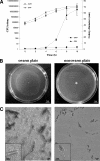Global gene expression profile for swarming Bacillus cereus bacteria
- PMID: 21642396
- PMCID: PMC3147438
- DOI: 10.1128/AEM.00245-11
Global gene expression profile for swarming Bacillus cereus bacteria
Abstract
Bacillus cereus can use swarming to move over and colonize solid surfaces in different environments. This kind of motility is a collective behavior accompanied by the production of long and hyperflagellate swarm cells. In this study, the genome-wide transcriptional response of B. cereus ATCC 14579 during swarming was analyzed. Swarming was shown to trigger the differential expression (>2-fold change) of 118 genes. Downregulated genes included those required for basic cellular metabolism. In accordance with the hyperflagellate phenotype of the swarm cell, genes encoding flagellin were overexpressed. Some genes associated with K(+) transport, phBC6A51 phage genes, and the binding component of the enterotoxin hemolysin BL (HBL) were also induced. Quantitative reverse transcription-PCR (qRT-PCR) experiments indicated an almost 2-fold upregulation of the entire hbl operon during swarming. Finally, BC1435 and BC1436, orthologs of liaI-liaH that are known to be involved in the resistance of Bacillus subtilis to daptomycin, were upregulated under swarming conditions. Accordingly, phenotypic assays showed reduced susceptibility of swarming B. cereus cells to daptomycin, and P(spac)-induced hyper-expression of these genes in liquid medium highlighted the role of BC1435 and BC1436 in the response of B. cereus to daptomycin.
Figures


References
-
- Aldridge P., Hughes K. T. 2002. Regulation of flagella assembly. Curr. Opin. Microbiol. 5:160–165 - PubMed
-
- Allison C., Lai H. C., Hughes C. 1992. Co-ordinate expression of virulence genes during swarm-cell differentiation and population migration of Proteus mirabilis. Mol. Microbiol. 6:1583–1591 - PubMed
-
- Andrews J. M. 2001. BSAC standardized disc susceptibility testing method. J. Antimicrob. Chemother. 48: 43–57 (Erratum 49:1049, 2002.) - PubMed
-
- Banks D. J., Beres S. B., Musser J. M. 2002. The fundamental contribution of phages to GAS evolution, genome diversification and strain emergence. Trends Microbiol. 10:515–521 - PubMed
Publication types
MeSH terms
Substances
LinkOut - more resources
Full Text Sources
Molecular Biology Databases
Research Materials

